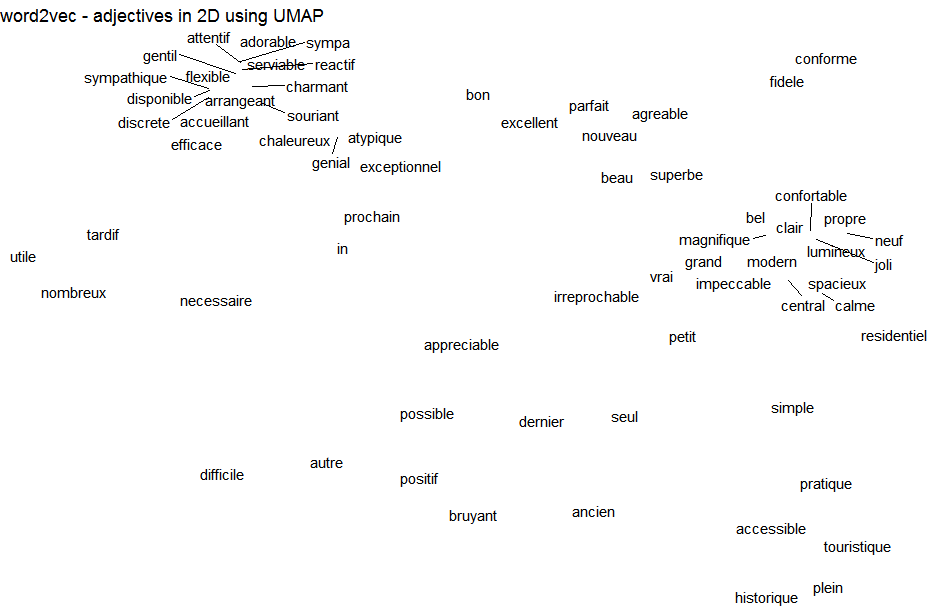
The hardware and bandwidth for this mirror is donated by METANET, the Webhosting and Full Service-Cloud Provider.
If you wish to report a bug, or if you are interested in having us mirror your free-software or open-source project, please feel free to contact us at mirror[@]metanet.ch.
This repository contains an R package allowing to build a word2vec model
install.packages("word2vec")remotes::install_github("bnosac/word2vec")Look to the documentation of the functions
help(package = "word2vec")library(udpipe)
data(brussels_reviews, package = "udpipe")
x <- subset(brussels_reviews, language == "nl")
x <- tolower(x$feedback)library(word2vec)
set.seed(123456789)
model <- word2vec(x = x, type = "cbow", dim = 15, iter = 20)
embedding <- as.matrix(model)
embedding <- predict(model, c("bus", "toilet"), type = "embedding")
lookslike <- predict(model, c("bus", "toilet"), type = "nearest", top_n = 5)
lookslike
$bus
term1 term2 similarity rank
bus gratis 0.9959141 1
bus tram 0.9898559 2
bus voet 0.9882312 3
bus ben 0.9854795 4
bus auto 0.9839599 5
$toilet
term1 term2 similarity rank
toilet koelkast 0.9870380 1
toilet douche 0.9850463 2
toilet werkte 0.9843599 3
toilet slaapkamers 0.9802811 4
toilet eigen 0.9759347 5write.word2vec(model, "mymodel.bin")
model <- read.word2vec("mymodel.bin")
terms <- summary(model, "vocabulary")
embedding <- as.matrix(model)
library(udpipe)
data(brussels_reviews_anno, package = "udpipe")
x <- subset(brussels_reviews_anno, language == "fr" & !is.na(lemma) & nchar(lemma) > 1)
x <- subset(x, xpos %in% c("NN", "IN", "RB", "VB", "DT", "JJ", "PRP", "CC",
"VBN", "NNP", "NNS", "PRP$", "CD", "WP", "VBG", "UH", "SYM"))
x$text <- sprintf("%s//%s", x$lemma, x$xpos)
x <- paste.data.frame(x, term = "text", group = "doc_id", collapse = " ")
model <- word2vec(x = x$text, dim = 15, iter = 20, split = c(" ", ".\n?!"))
embedding <- as.matrix(model)library(uwot)
viz <- umap(embedding, n_neighbors = 15, n_threads = 2)
## Static plot
library(ggplot2)
library(ggrepel)
df <- data.frame(word = gsub("//.+", "", rownames(embedding)),
xpos = gsub(".+//", "", rownames(embedding)),
x = viz[, 1], y = viz[, 2],
stringsAsFactors = FALSE)
df <- subset(df, xpos %in% c("JJ"))
ggplot(df, aes(x = x, y = y, label = word)) +
geom_text_repel() + theme_void() +
labs(title = "word2vec - adjectives in 2D using UMAP")
## Interactive plot
library(plotly)
plot_ly(df, x = ~x, y = ~y, type = "scatter", mode = 'text', text = ~word)library(word2vec)
model <- read.word2vec(file = "cb_ns_500_10.w2v", normalize = TRUE)predict(model, newdata = c("fries", "money"), type = "nearest", top_n = 5)
$fries
term1 term2 similarity rank
fries burgers 0.7641346 1
fries cheeseburgers 0.7636056 2
fries cheeseburger 0.7570285 3
fries hamburgers 0.7546136 4
fries coleslaw 0.7540344 5
$money
term1 term2 similarity rank
money funds 0.8281102 1
money cash 0.8158758 2
money monies 0.7874741 3
money sums 0.7648080 4
money taxpayers 0.7553093 5wv <- predict(model, newdata = c("king", "man", "woman"), type = "embedding")
wv <- wv["king", ] - wv["man", ] + wv["woman", ]
predict(model, newdata = wv, type = "nearest", top_n = 3)
term similarity rank
king 0.9479475 1
queen 0.7680065 2
princess 0.7155131 3wv <- predict(model, newdata = c("belgium", "government"), type = "embedding")
predict(model, newdata = wv["belgium", ] + wv["government", ], type = "nearest", top_n = 2)
term similarity rank
netherlands 0.9337973 1
germany 0.9305047 2
predict(model, newdata = wv["belgium", ] - wv["government", ], type = "nearest", top_n = 1)
term similarity rank
belgium 0.9759384 1wv <- predict(model, newdata = c("black", "white", "racism", "person"), type = "embedding")
wv <- wv["white", ] - wv["person", ] + wv["racism", ]
predict(model, newdata = wv, type = "nearest", top_n = 10)
term similarity rank
black 0.9480463 1
racial 0.8962515 2
racist 0.8518659 3
segregationists 0.8304701 4
bigotry 0.8055548 5
racialized 0.8053641 6
racists 0.8034531 7
racially 0.8023036 8
dixiecrats 0.8008670 9
homophobia 0.7886864 10
wv <- predict(model, newdata = c("black", "white"), type = "embedding")
wv <- wv["black", ] + wv["white", ]
predict(model, newdata = wv, type = "nearest", top_n = 3)
term similarity rank
blue 0.9792663 1
purple 0.9520039 2
colored 0.9480994 3library(quanteda)
library(word2vec)
data("data_corpus_inaugural", package = "quanteda")
toks <- data_corpus_inaugural %>%
corpus_reshape(to = "sentences") %>%
tokens(remove_punct = TRUE, remove_symbols = TRUE) %>%
tokens_tolower() %>%
as.list()
set.seed(54321)
model <- word2vec(toks, dim = 25, iter = 20, min_count = 3, type = "skip-gram", lr = 0.05)
emb <- as.matrix(model)
predict(model, c("freedom", "constitution", "president"), type = "nearest", top_n = 5)
$freedom
term1 term2 similarity rank
freedom human 0.9094619 1
freedom man 0.9001195 2
freedom life 0.8840834 3
freedom generations 0.8676646 4
freedom mankind 0.8632550 5
$constitution
term1 term2 similarity rank
constitution constitutional 0.8814662 1
constitution conformity 0.8810275 2
constitution authority 0.8786194 3
constitution prescribed 0.8768463 4
constitution states 0.8661923 5
$president
term1 term2 similarity rank
president clinton 0.9552274 1
president clergy 0.9426718 2
president carter 0.9386149 3
president chief 0.9377645 4
president reverend 0.9347451 5library(tokenizers.bpe)
library(word2vec)
data(belgium_parliament, package = "tokenizers.bpe")
x <- subset(belgium_parliament, language == "french")
x <- x$text
tokeniser <- bpe(x, coverage = 0.999, vocab_size = 1000, threads = 1)
toks <- bpe_encode(tokeniser, x = x, type = "subwords")
toks <- bpe_encode(tokeniser, x = x, type = "ids")
model <- word2vec(toks, dim = 25, iter = 20, min_count = 3, type = "skip-gram", lr = 0.05)
emb <- as.matrix(model)Need support in text mining? Contact BNOSAC: http://www.bnosac.be
These binaries (installable software) and packages are in development.
They may not be fully stable and should be used with caution. We make no claims about them.